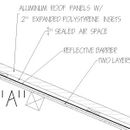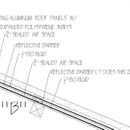Roof Assembly for Hot-Humid Climate
We are working on a remodel project in Central Florida. At one time someone enclosed a porch with 2″ Expanded polystyrene. This does not work well enough for the new project. We are debating on finishing the roof as this picture drawing A, Using 1×4 furring, air space, reflective barrier then 2 layers of ISO rigid insulation. Would it be better to use two layers of furring where it would create two separate sealed air spaces also using two layers of reflective barrier as in Drawing B ?
Is there any suggestions to improve this detail?
GBA Detail Library
A collection of one thousand construction details organized by climate and house part











Replies
With the air spaces, aren't you decoupling the insulation layer from the structure?
What about this approach (https://www.greenbuildingadvisor.com/article/combining-exterior-rigid-foam-with-fluffy-insulation) with 2 inches of rigid on the outside of the sheathing and fiberglass on the inside?
The structure is there for the most part. The 12" wise x 3" tall pans lock together forming a structural roof. (Not rated for snow of course) It is not my choice for a finished room by any means for strength. This is another reason we are exploring this phase to weigh out removing the entire roof and conventionally framing it back. As it is now the owner has chosen to go exposed beams to add structure, which it defiantly will. (shown in dwg.) The cost to remove nd remove would not allow much of the projected work to happen. We need to keep the outside as it is. I am not sure how much advantage there is to using double air space for insulation. I would think it would increase R value in the overall system? And if using two layers of reflexives has any advantage. The R Value would help the owner make a final decision.
Hi Gary,
I haven't been able to find a discussion that addresses this type of stackup. My concern is that you are creating a thermal break between the two insulation layers. Let's see if one of the experts will weigh in with some science-based input.
I'm also wondering how the conductivity of the metal pans affects the R-value of the assembly.
"Let's see if one of the experts will weigh in with some science-based input." Yes, Is what I am hoping for.